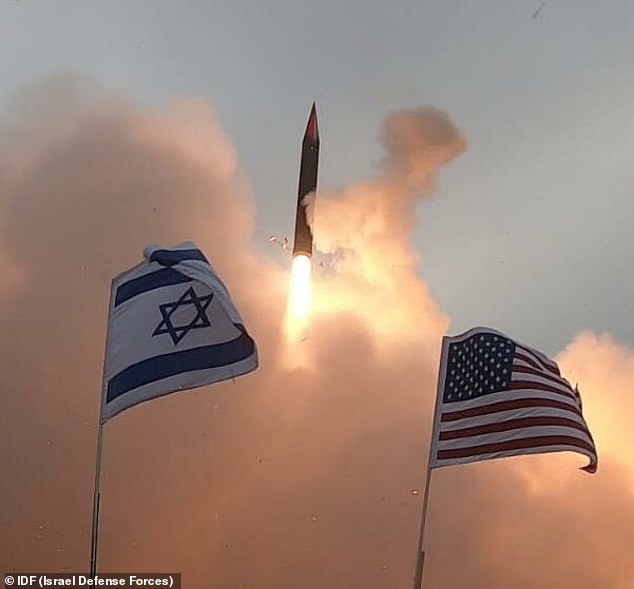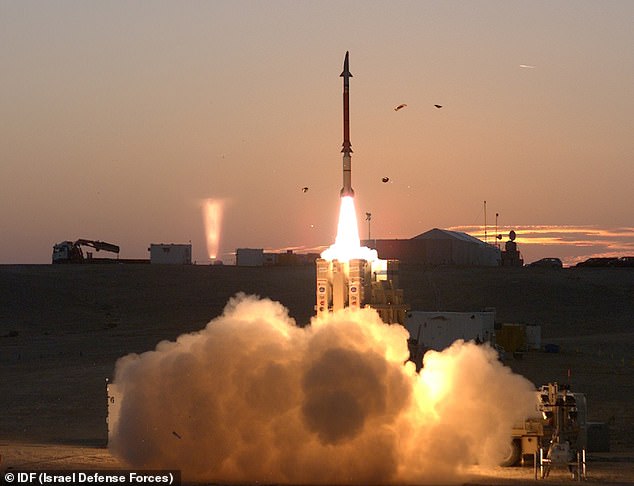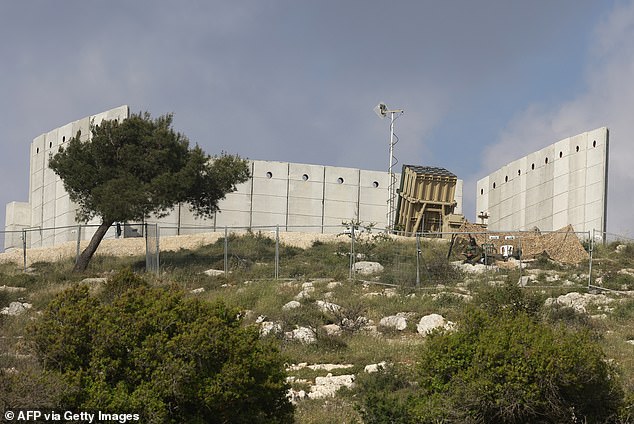Table of Contents
An intricate network of Israel’s missile defense technology faced a serious test of its mettle Saturday night, shooting down “99 percent” of an airstrike launched from Iran.
Approximately 170 Iranian drones, 120 ballistic missiles and more than 30 cruise missiles were launched from Iranian territory in the attack, reaching more than 1,100 miles.
Iran’s airborne phalanx was repelled by ground-based anti-aircraft missiles with names like ‘Iron Dome’, ‘David’s Sling’ and ‘Arrow-3’, the latest hardware in Israel’s frequently upgraded national defense arsenal.
Below is an overview of the equipment Israel has developed, sometimes with the help of American military contractors, and how it keeps the bombings under control.
First operating in 2011, Israel’s Iron Dome faced its first test more than a decade ago, when militants in Gaza fired approximately 1,500 rockets into Israel over eight days in November 2014; There are at least 10 Iron Dome missile batteries known to exist, in total (like this one shown above)
iron dome
Israel’s Iron Dome, first operational in 2011, faced its first test more than a decade ago, when militants in Gaza fired approximately 1,500 rockets into Israel over eight days in November 2014.
In the dome’s decade of operation, Israel Defense Forces officials have reported a 90 percent success rate: a statistic that is difficult to assess given that the system is designed to attack only those rockets that are in path and cause real damage.
Each of the 10 Iron Dome missile batteries known to exist is equipped with a radar to detect airborne targets and a connection to an automated command and control system for remote firing calculations.
When one of the Dome’s missile batteries detects a rocket on radar, it transmits speed and trajectory data to its control center, which then uses that information to determine whether the rocket is likely to hit a populated area.
A missile is fired from the battery’s array of 20 interceptor missiles only if the detected rocket missile poses a genuine threat, a cost-saving measure given the barrage of low-tech rockets fired by Hamas, Hezbollah and other regional militants, whose equipment tends to be less than accurate.

Israel’s solution to the Iron Dome cost problem, the Iron Beam laser, is currently in development. Above, President Joe Biden walks with Israeli Defense Minister Benny Gantz (to Biden’s left) in front of an Iron Beam prototype (left) and an Iron Dome battery (right) in July 2022.
The Iron Dome system is also designed to intercept rockets and missiles flying in high arcs, which can otherwise make objects more difficult to counterattack.
But the hardware has not been without criticism at the national level. Early in their operation, a military analyst and former fighter pilot from Tel Aviv University in Israel, Reuven Pedatzurfor example, he argued that the Iron Dome was too expensive.
The militants, Pedatzur argued, could effectively drain Israel’s budget, as the expensive Dome missiles, which can cost up to $100,000 each, were wasted on the militants’ dramatically cheaper rockets, which at the time cost around $5. .
Israel’s laser blast solution to solve the cost problem, called Iron Beam, is currently in development.
Iron Beam’s 100 kilowatt laser is designed to intercept and detonate threats as structurally different as rockets, artillery, mortars and drones from miles away.
“I had seen the system the last time I went to Israel, I saw the first prototype,” U.S. Army Undersecretary for Acquisition, Logistics and Technology Doug Bush said last November. “It’s intriguing.”
“There is potential, if theirs works well, it could be something we could think about leveraging for our needs in that space,” Bush said. DefenseScoopadding that the Iron Beam served as a complement to the Pentagon’s Indirect Fire Protection Capable High Energy Laser Prototype (IFPC-HEL) program.

Israel’s latest and arguably best current system, Arrow 3, was created specifically to shoot down ballistic missiles armed with nuclear and other “unconventional” warheads from space trajectories (above).

Like the Arrow-3, David’s Sling, formerly called the Magic Wand, is a two-stage sling with a powerful range to intercept larger missiles. These anti-aircraft missiles have a range of 160 miles and can travel at speeds up to Mach 7.5 (above 0
Arrow-3
Israel’s latest and arguably best current system, Arrow 3, was created specifically to shoot down ballistic missiles armed with nuclear and other “unconventional” warheads from space trajectories.
Israel’s top military spokesman, Rear Admiral Daniel Hagari, said after last Saturday’s attack that the Arrow-3 had “proven its effectiveness against a significant number of ballistic missiles” fired by Iran this weekend.
Its missile interceptor missiles are significantly larger than those fired by Iron Dome, which typically measure only 6 inches wide and 10 feet long, and are guided by miniature sensors for short-range rocket targets.
The Arrow-3 missiles, on the other hand, are two-stage rockets, 23 feet long and can reach hypersonic speeds.
David’s Sling
Like the Arrow-3, David’s Sling, formerly called ‘Magic Wand’, is a two-stage rocket with a powerful range to intercept larger missiles.
According to the Missile Threat project of Center for International and Strategic Studies (CSIS), the system uses both Stunner and SkyCeptor kinetic interceptors called “hit to kill”.
These anti-aircraft missiles have a range of more than 160 miles and can travel at blinding speeds of up to Mach 7.5.
The SkyCeptor, in particular, was designed to be a more cost-effective but no less effective replacement for the American-made Patriot missiles.
Each of these interceptors has two guidance and guidance systems installed at the tip of the missile’s nose, along with an electro-optical sensor for further identification of its target.
David’s Sling was a collaboration between Israeli defense firm Rafael Advanced Defense Systems and American defense titan Raytheon, which has made everything from radars for fighter jets to NSA listening posts for domestic national security. Joined.
Originally, the joint project had been developed specifically to combat medium-range missiles allegedly in possession of the Hezbollah militant group in Lebanon, northern Israel.
But other US allies are now seeking partnerships with Raytheon for their own version of SkyCeptor, including Romania, which began a three-year investment project in 2023 to build missile interceptors, in part because of the conflict in nearby Ukraine.


